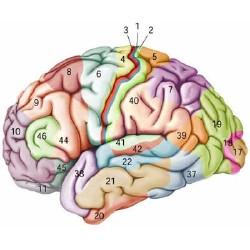
This image shows a human brain with Brodmann's cytoarchitectonic areas superimposed.
Computation in Neural Circuits
It is likely that almost everything you can see around you at this moment has been created or modified by the kilogram and a half of neural matter which we humans carry around in our heads. It is incredible that we can perform such world-changing feats of thought, planning, and action with an organ we can hold in our two hands. In the last 150 years, our knowledge of the brain has grown from almost nothing to the current appreciation of its intricate structure, and some understanding of its function.
Its 100 billion neurons assemble their 100 trillion connections without any explicit design or designer. Instead, this incredible complexity arises from simple rules controlling cell division and migration, and specifying the way individual neurons grow their connections to other cells. Using simulations of simple elements, we want to understand how a single set of rules contained in a single cell can develop into a complex, patterned, self-repairing organism.
Much of the power of our brains seems to be due to the neocortex, which is essentially a layered sheet of neurons, 2mm thick, that is folded to fit inside our skull. The 'canonical circuit' hypothesis we have developed is that the circuits in different regions of the neocortex in mammals all share a common basic structure and function. This idea of a basic uniformity may seem paradoxical given the many different functions that the neocortex has. Thus testing our canonical circuit hypothesis at all levels of structure, function and computation is one serious step in understanding how the mammalian neocortex works.